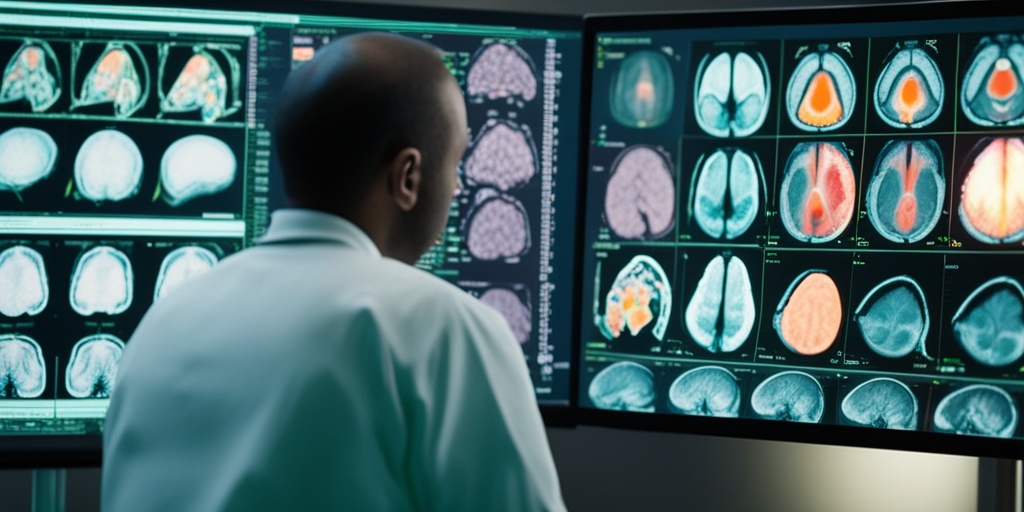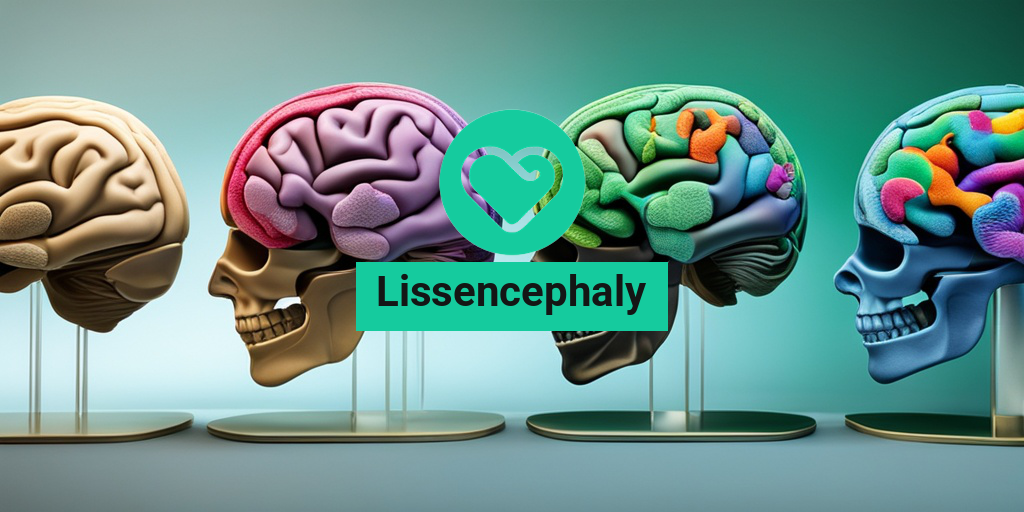“`html
What Is Lissencephaly?
Lissencephaly is a rare and serious brain malformation characterized by the absence of normal folds and grooves in the cerebral cortex. The term “lissencephaly” comes from the Greek words “lissos,” meaning smooth, and “kephale,” meaning head. This condition results in a smooth brain surface, which can lead to significant developmental challenges.
Understanding the Brain Structure
In a typical brain, the cerebral cortex has numerous folds (gyri) and grooves (sulci) that increase its surface area and allow for complex functions. In individuals with lissencephaly, the brain appears unusually smooth, which can disrupt normal brain function and development.
Types of Lissencephaly
Lissencephaly is generally classified into two main types:
- Classic Lissencephaly: This type is characterized by a complete absence of gyri and sulci, leading to severe developmental delays.
- Subcortical Band Heterotopia: In this variant, there are some folds, but they are abnormal, and a band of gray matter is found beneath the cortex.
Causes of Lissencephaly
The causes of lissencephaly are often linked to genetic mutations that affect brain development during pregnancy. Some of the known genetic factors include:
- Mutations in the LIS1 gene: This gene is crucial for proper brain development.
- Other genetic syndromes: Conditions such as Miller-Dieker syndrome can also lead to lissencephaly.
Environmental factors during pregnancy, such as exposure to certain infections or drugs, may also contribute to the risk of developing this condition.
Lissencephaly Symptoms
The symptoms of lissencephaly can vary widely depending on the severity of the condition and the specific areas of the brain affected. Common symptoms include:
- Developmental Delays: Children with lissencephaly often experience significant delays in reaching developmental milestones, such as sitting, walking, and talking.
- Seizures: Many individuals with lissencephaly suffer from seizures, which can range from mild to severe.
- Muscle Tone Abnormalities: Hypotonia (decreased muscle tone) is common, leading to difficulties with movement and coordination.
- Intellectual Disabilities: Cognitive impairments are prevalent, with many affected individuals experiencing varying degrees of intellectual disability.
- Feeding Difficulties: Infants may have trouble feeding due to poor muscle control.
Life Expectancy and Prognosis
The life expectancy for individuals with lissencephaly can vary significantly. While some may live into adulthood, others may face severe health complications that can shorten their lifespan. Factors influencing life expectancy include:
- Severity of Symptoms: More severe symptoms often correlate with a shorter life span.
- Access to Medical Care: Early intervention and ongoing medical support can improve quality of life and potentially extend life expectancy.
Diagnosis and Treatment
Diagnosis of lissencephaly typically involves imaging studies such as MRI or ultrasound, which can reveal the characteristic smooth appearance of the brain. Unfortunately, there is currently no cure for lissencephaly, but treatment focuses on managing symptoms and providing supportive care. This may include:
- Physical Therapy: To help improve motor skills and muscle tone.
- Occupational Therapy: To assist with daily living skills.
- Medications: To control seizures and other symptoms.
For families navigating the complexities of lissencephaly, resources like Yesil Health AI can provide valuable, evidence-based health answers and support.
In conclusion, lissencephaly is a complex condition that requires a multidisciplinary approach for management. Understanding the symptoms and available treatments can empower families to seek the best care for their loved ones. If you suspect your child may have lissencephaly or are seeking more information, consult with a healthcare professional for guidance.
“`

“`html
Lissencephaly Causes
Lissencephaly, often referred to as “smooth brain,” is a rare neurological condition characterized by the absence of normal brain folds and grooves. This condition can lead to a variety of developmental and cognitive challenges. Understanding the causes of lissencephaly is crucial for parents and caregivers, as it can help in managing the condition and planning for the future.
Genetic Factors
One of the primary causes of lissencephaly is genetic mutations. These mutations can occur spontaneously or be inherited from parents. Some of the most common genetic syndromes associated with lissencephaly include:
- Lis1 gene mutations: This gene plays a critical role in brain development, and mutations can lead to lissencephaly.
- DCX gene mutations: The doublecortin gene is essential for neuronal migration, and its mutations can result in lissencephaly.
- Other genetic syndromes: Conditions such as Miller-Dieker syndrome and Walker-Warburg syndrome are also linked to lissencephaly.
Environmental Factors
While genetic factors are significant, environmental influences during pregnancy can also contribute to the development of lissencephaly. Some potential environmental causes include:
- Infections: Certain infections during pregnancy, such as cytomegalovirus (CMV) or Zika virus, can disrupt normal brain development.
- Substance abuse: The use of drugs, alcohol, or certain medications during pregnancy can negatively impact fetal brain development.
- Maternal health issues: Conditions like diabetes or hypertension in the mother can also increase the risk of developmental disorders in the baby.
Understanding the Risk Factors
Identifying risk factors can help in early detection and intervention. Some of the risk factors associated with lissencephaly include:
- Family history: A family history of genetic disorders may increase the likelihood of lissencephaly.
- Advanced maternal age: Mothers over the age of 35 may have a higher risk of having a child with genetic abnormalities.
- Previous pregnancies: A history of previous pregnancies with neurological disorders can also be a risk factor.
Lissencephaly Diagnosis
Diagnosing lissencephaly typically involves a combination of clinical evaluation and advanced imaging techniques. Early diagnosis is essential for effective management and support for affected individuals.
Clinical Evaluation
The diagnostic process often begins with a thorough clinical evaluation. Healthcare providers will assess the child’s developmental milestones and look for signs of neurological impairment. Common symptoms that may prompt further investigation include:
- Seizures: Frequent seizures can be a significant indicator of lissencephaly.
- Delayed development: Children with lissencephaly may experience delays in reaching developmental milestones.
- Muscle tone abnormalities: Hypotonia (decreased muscle tone) or hypertonia (increased muscle tone) can also be observed.
Imaging Techniques
Once a clinical evaluation suggests the possibility of lissencephaly, imaging studies are typically conducted. The most common imaging techniques include:
- Ultrasound: Prenatal ultrasounds can sometimes detect lissencephaly before birth, particularly if there are other associated abnormalities.
- Magnetic Resonance Imaging (MRI): An MRI is the gold standard for diagnosing lissencephaly. It provides detailed images of the brain’s structure, allowing doctors to identify the absence of normal folds.
- Computed Tomography (CT) scans: In some cases, CT scans may be used to visualize brain structure, although MRI is preferred for its superior detail.
Genetic Testing
In addition to imaging, genetic testing may be recommended to identify specific genetic mutations associated with lissencephaly. This can provide valuable information for prognosis and potential treatment options.
In conclusion, understanding the causes and diagnosis of lissencephaly is vital for families navigating this complex condition. Early detection and intervention can significantly improve the quality of life for affected individuals. If you suspect your child may have lissencephaly, consult with a healthcare professional for a comprehensive evaluation and support.
“`

“`html
Lissencephaly Treatment Options
Lissencephaly, often referred to as “smooth brain,” is a rare brain malformation characterized by the absence of normal folds and grooves in the cerebral cortex. This condition can lead to a variety of neurological issues, and while there is no cure, several treatment options can help manage symptoms and improve the quality of life for affected individuals.
Medical Management
Medical management is a cornerstone of treatment for lissencephaly. This typically involves:
- Antiepileptic Medications: Many individuals with lissencephaly experience seizures. Antiepileptic drugs (AEDs) can help control these seizures and improve overall neurological function.
- Physical Therapy: Physical therapy can assist in improving motor skills and mobility. Tailored exercises can help strengthen muscles and enhance coordination.
- Occupational Therapy: This therapy focuses on helping individuals develop daily living skills and improve their ability to perform everyday tasks.
- Speech Therapy: For those with communication challenges, speech therapy can be beneficial in developing verbal and non-verbal communication skills.
Surgical Interventions
In some cases, surgical options may be considered, especially if the individual experiences severe seizures that are not responsive to medication. Possible surgical interventions include:
- Corpus Callosotomy: This procedure involves severing the corpus callosum, the bundle of nerves connecting the two hemispheres of the brain, to reduce the frequency and severity of seizures.
- Vagus Nerve Stimulation (VNS): A device is implanted to stimulate the vagus nerve, which can help reduce seizure activity.
Supportive Care
Supportive care is essential for individuals with lissencephaly. This includes:
- Regular Monitoring: Regular check-ups with healthcare providers to monitor neurological development and adjust treatment plans as necessary.
- Family Support: Counseling and support groups for families can provide emotional support and practical advice on managing the challenges associated with lissencephaly.
- Educational Support: Special education services can help children with lissencephaly thrive in a learning environment tailored to their needs.
Lissencephaly Prognosis
The prognosis for individuals with lissencephaly can vary significantly based on the severity of the condition and the presence of associated health issues. Understanding the prognosis is crucial for families as they navigate the complexities of this condition.
Life Expectancy
Life expectancy for individuals with lissencephaly can be challenging to predict. Some children may live into adulthood, while others may have a shorter life span due to complications such as:
- Severe Seizures: Frequent and uncontrolled seizures can lead to additional health complications.
- Respiratory Issues: Individuals may be at risk for respiratory infections or complications, particularly if they have difficulty swallowing.
- Neurological Decline: Progressive neurological decline can occur in some cases, impacting overall health and longevity.
Quality of Life
While the prognosis can be uncertain, many individuals with lissencephaly can lead fulfilling lives with appropriate interventions and support. Factors that can positively influence quality of life include:
- Early Intervention: Early diagnosis and intervention can significantly improve developmental outcomes.
- Access to Therapies: Regular access to physical, occupational, and speech therapies can enhance daily functioning.
- Family and Community Support: A strong support system can provide emotional and practical assistance, improving overall well-being.
In conclusion, while lissencephaly presents unique challenges, understanding treatment options and prognosis can empower families to make informed decisions and advocate for the best care for their loved ones. 🌟
“`

“`html
Lissencephaly Support and Resources
Lissencephaly, often referred to as “smooth brain,” is a rare brain malformation that can significantly impact a child’s development and quality of life. For families navigating this complex condition, finding the right support and resources is crucial. Here, we explore various avenues for assistance, information, and community connection.
Understanding Lissencephaly
Before diving into support resources, it’s essential to understand what lissencephaly is. This condition is characterized by a lack of normal folds in the brain, leading to a smooth appearance. It can result in a range of symptoms, including developmental delays, seizures, and difficulties with motor skills. The severity of these symptoms can vary widely among affected individuals.
Support Groups and Communities
Connecting with others who understand the challenges of lissencephaly can be incredibly beneficial. Here are some resources to consider:
- Online Support Groups: Websites like Lissencephaly Network offer forums and chat groups where parents can share experiences and advice.
- Social Media Communities: Platforms like Facebook have dedicated groups for families affected by lissencephaly, providing a space for sharing stories, resources, and emotional support.
- Local Support Groups: Check with local hospitals or pediatric clinics for support groups that may focus on neurological disorders.
Educational Resources
Education is key when it comes to understanding lissencephaly and advocating for your child. Here are some valuable resources:
- Books and Articles: Look for literature that discusses lissencephaly in detail. Many medical professionals publish articles that can provide insights into the condition.
- Webinars and Workshops: Organizations often host educational sessions that cover various aspects of lissencephaly, including management strategies and therapies.
- Medical Professionals: Regular consultations with neurologists and geneticists can provide tailored information and guidance for your child’s specific needs.
Financial Assistance
The financial burden of caring for a child with lissencephaly can be overwhelming. Here are some options for financial support:
- Insurance Coverage: Ensure you understand your insurance policy and what it covers regarding therapies and treatments.
- Government Assistance: Programs like Medicaid and Social Security can provide financial aid for families with children who have disabilities.
- Nonprofit Organizations: Some nonprofits offer grants or financial assistance for families dealing with rare conditions like lissencephaly.
Therapeutic Resources
Therapies can play a crucial role in improving the quality of life for children with lissencephaly. Consider the following:
- Physical Therapy: Helps improve motor skills and coordination.
- Occupational Therapy: Focuses on enhancing daily living skills and independence.
- Speech Therapy: Aids in communication skills, which can be particularly beneficial for children with developmental delays.
Lissencephaly in Children
Lissencephaly can present unique challenges for children and their families. Understanding the condition and its implications is vital for effective management and support.
Symptoms of Lissencephaly
Children with lissencephaly may exhibit a variety of symptoms, which can include:
- Developmental Delays: Many children experience delays in reaching developmental milestones.
- Seizures: Seizures are common and can vary in frequency and severity.
- Motor Skill Challenges: Difficulties with movement and coordination are often observed.
- Feeding Difficulties: Some children may struggle with feeding due to muscle tone issues.
Diagnosis and Treatment
Diagnosing lissencephaly typically involves imaging studies such as ultrasounds or MRIs, which can reveal the characteristic smooth appearance of the brain. Once diagnosed, treatment focuses on managing symptoms and improving quality of life:
- Medications: Antiepileptic drugs may be prescribed to manage seizures.
- Therapies: As mentioned earlier, physical, occupational, and speech therapies can be beneficial.
- Regular Monitoring: Ongoing assessments by healthcare professionals are crucial to adapt treatment plans as needed.
Life Expectancy and Prognosis
The life expectancy for children with lissencephaly varies widely, depending on the severity of the condition and associated health issues. While some children may live into adulthood, others may face significant health challenges that can impact their lifespan. Early intervention and comprehensive care can improve outcomes and enhance quality of life.
In conclusion, while lissencephaly presents numerous challenges, understanding the condition and accessing the right support can make a significant difference for affected children and their families. 🌈
“`

“`html
Frequently Asked Questions about Lissencephaly
What is Lissencephaly?
Lissencephaly is a rare brain disorder characterized by the absence of normal folds and grooves in the brain’s surface. This condition can lead to various neurological issues and developmental delays.
What are the symptoms of Lissencephaly?
Common symptoms associated with lissencephaly include:
- Severe developmental delays
- Seizures
- Muscle stiffness or weakness
- Difficulty feeding
- Abnormal facial features
What causes Lissencephaly?
The primary causes of lissencephaly are genetic mutations that affect brain development during pregnancy. These mutations can be inherited or occur spontaneously.
What is the life expectancy for individuals with Lissencephaly?
The life expectancy for individuals with lissencephaly varies widely depending on the severity of the condition and associated health issues. Some may live into adulthood, while others may have a shorter lifespan due to complications.
How is Lissencephaly diagnosed?
Lissencephaly is typically diagnosed through imaging techniques such as MRI or CT scans, which can reveal the characteristic smooth appearance of the brain.
What is the treatment for Lissencephaly?
While there is no cure for lissencephaly, treatment focuses on managing symptoms and may include:
- Physical therapy
- Occupational therapy
- Medications to control seizures
- Supportive care for feeding and nutrition
Can Lissencephaly be detected during pregnancy?
Yes, ultrasound imaging can sometimes detect signs of lissencephaly during pregnancy, particularly in the second trimester. However, a definitive diagnosis is usually made after birth.
How do you pronounce Lissencephaly?
The pronunciation of lissencephaly is “lis-en-SEF-uh-lee.”
Is there a specific ICD-10 code for Lissencephaly?
Yes, the ICD-10 code for lissencephaly is Q04.0, which is used for medical billing and documentation purposes.
Where can I find support for families affected by Lissencephaly?
Support groups and online communities can provide valuable resources and connections for families dealing with lissencephaly. Organizations such as the Lissencephaly Network offer information and support.
“`




